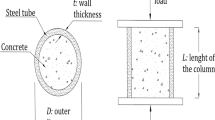Abstract
In the present study, the effect of steel fibres on the torsional behaviour of concrete elements has been studied by performing experiments on cylindrical beams. The percentages of steel fibres used were 0.5%, 0.75%, and 1% by volume of concrete. Three cylindrical concrete beam specimens of each percentage of fibre along with three specimens of plain concrete were cast and tested under torsion after 28 days of curing. Simultaneously, 150 mm cubes were also cast from each mix and were tested under a 200-ton compression testing machine, and the stress–strain curves were obtained. Addition of steel fibres increased the ultimate torsional strength of concrete beams and improved the ductility. The percentage increase in the ultimate torsional strength for 0.5%, 0.75% and 1.0% fibre content by volume in concrete over plain concrete elements was 15.6%, 23.12% and 38.15%, respectively. Apart from the experimental work, two different unified models using Artificial Neural Network (ANN) have also been developed in this study, namely, ANN-1 and ANN-2 models. The ANN-1 model predicts the stress–strain curve, while the ANN-2 model predicts the torque-twist curve. These ANN models are trained using the experimental data collected in this study. The performances of developed ANN models were evaluated, and the results were compared with the experimental results. It was found that the predictions by the developed ANN models are in good agreement with experimental results.









































Similar content being viewed by others
References
Porter HF (1910) Preparation of concrete from selection of materials to final disposition. Proc. National Association of cement users, Am Conc Inst 6:296
Romualdi JP, Batson GB (1963) Mechanics of crack arrest in concrete. J Eng Mech Div Proc Am Soc Civ Eng 89(3):147–168
Shah SP, Ranjan BV (1971) Fibre reinforced concrete properties. ACI J
Batson GB, Ball C, Bailey L, Hooks J, Lankard E (1972) Flexural fatigue strength of SFRC beams. J ACI 69:673–677
Williamson GR (1974) Effect of steel fibre on compressive strength of concrete. ACI publication SP-44, pp 195–208
Krenchel H (1974) Fibre reinforcement brittle matrix material. ACI publication SP-44, pp 45–78
Walkers BR, Jonuszkiewiez A, Jeruzal J (1979) Concrete Composites with cut steel fibre reinforcement subjected to uniaxial tension. J ACI Proc 76(10)
Ramakrishnan V, Brandahang T, M V, Schrader EK (1980) A comparative evaluation of concrete reinforced with straight fibres and fibres with deformed ends glued together into bundles. J ACI 7(3)
Kukreja CB (1981) Structural characteristics of steel fibre reinforced concrete. Ph.D. thesis, U.O.R., Roorkee
Special Publication of ACI 544 (1984) Guide for specifying, mixing, placing and finishing of SFRC. Journal of ACI, Report No. 54-3R-84, vol 81
Kaushik SK, Gupta VK, Tarafdar NK (1987) Behaviour of FRC beams in shear. Proc. of international symposium on fibre reinforced concrete, December 16–19, vol 1, Madras, India, 1987, pp 1.133–1.149
Coeradini C, Scoccia G, Volpe R (1987) Statistical evaluation of effect of cement content, water/cement ratio and fibre content on the physical-mechanical properties of SFRC. Proceeding of international symposium on fibre, reinforced concrete, December 16–19, vol 1, Madras, India, 1987, pp 1.185–1.196.
Dwarkanath HV, Nagraj TS (1987) Flexural behaviour of reinforced fibre concrete beams. Proceeding of international symposium on fibre reinforced concrete, December 16–19, vol I, 1987, Madras, India, pp 2.49–2.58
Chern JC, Young CH (1990) Study of Factors influencing drying shrinkage of SFRC. ACI J 87:123
Mansur MA, Ong KCG (1991) Behaviour of FRC deep beams in shear. ACI 88(1):98–105
Tan KH, Parmasivam P, Tan KC (1994) Instantaneous and long era deflections of Steel FRC Beams. ACI Struct J 91(4):384–393
Yin W, Hsu TC (1995) Fatigue behaviour of steel fibre reinforced concrete in uniaxial and biaxial compression. ACI Mater J 92(1):71–81
Balaguru P, Foden A (1996) Properties of fibre reinforced structural light weight concrete. ACI Struct J 93(1):62–78
Muzhir SM, Naqvi SQA, Quadeer A, Israil M (1996) FRC as an alternative to Timber for the door, window frames and beams. A national seminar on high-performance concrete, Bangalore, February 1996
Soulioti D, Barkoula NM, Paipetis A, Matikas TE, Shiotani T, Aggelis DG (2009) 2009 Acoustic emission behavior of steel fibre reinforced concrete under bending. Constr Build Mater 23(12):3532–3536
Mahmud GH, Yang Z, Hassan AMT (2013) Experimental and numerical studies of size effects of Ultra High Performance Steel Fibre Reinforced Concrete (UHPFRC) beams. Construct Build Mater 48:1027–1034
Amin A, Foster SJ (2016) Shear strength of steel fibre reinforced concrete beams with stirrups. Eng Struct 111:323–332
Zurada JM (1990) Introduction to artificial neural systems. Jaico Publishing House, Mumbai
Schalkoff RJ (1997) Artificial neural networks. The McGraw Hill Companies Inc, New York
Hagan MT, Menhaj M (1994) Training feed-forward networks with the Marquardt algorithm. IEEE Trans Neural Netw 5(6):989–993
Author information
Authors and Affiliations
Corresponding author
Ethics declarations
Conflict of interest
On behalf of all authors, the corresponding author states that there is no conflict of interest.
Rights and permissions
About this article
Cite this article
Bilal, A., Israil, M. & Ayaz, M. Effect of steel fibres on the torsional behaviour of concrete elements: unified model using Artificial Neural Networks. Innov. Infrastruct. Solut. 6, 129 (2021). https://doi.org/10.1007/s41062-021-00479-z
Received:
Accepted:
Published:
DOI: https://doi.org/10.1007/s41062-021-00479-z




